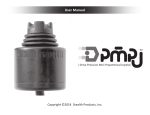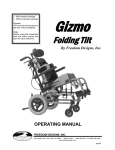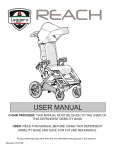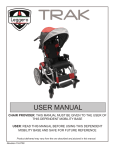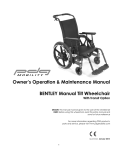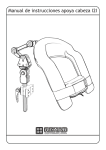Download i-Fit Positioning Products
Transcript
i-Fit Positioning belts, posture supports and straps i-Fit Positioning Products Usage Guide and Maintenance Manual for i-Fit Line of Belts, Posture Supports, Straps and Accessories 2014 Stealth Products, Inc. Copyright © 2014 Stealth Products, Inc. All rights reserved. Published by Stealth Products, Inc. February 17, 2014 DOC-000009; Rev 6 Stealth Products, Inc. 104 John Kelly Drive Burnet, Texas 78611 Tel: (512) 715-9995 Toll Free: 1(800) 965-9229 Fax: (512) 715-9954 Toll Free: 1(800) 806-1225 Email: [email protected] i-Fit™ and Stealth Products® are trademarks of Stealth Products, LLC. 2 Table of Contents Contents Introduction1.0 . . . . . . . . . . . . . . . . . . . . . . . . . . . . . . . . . . . . . . . . . . . . . . 4 Terms of Use 2.0 . . . . . . . . . . . . . . . . . . . . . . . . . . . . . . . . . . . . . . . . . . . . . . 4 Definition of Warnings 3.0 . . . . . . . . . . . . . . . . . . . . . . . . . . . . . . . . . . . . . . . . . . . . . . 5 Supplier Reference 4.0 . . . . . . . . . . . . . . . . . . . . . . . . . . . . . . . . . . . . . . . . . . . . . . 5 Important Information 5.0 . . . . . . . . . . . . . . . . . . . . . . . . . . . . . . . . . . . . . . . . . . . . . . 6 Motor Vehicle Use 5.1 . . . . . . . . . . . . . . . . . . . . . . . . . . . . . . . . . . . . . . . . . . . . . . 6 Care and Maintenance 6.0 . . . . . . . . . . . . . . . . . . . . . . . . . . . . . . . . . . . . . . . . . . . . . . 7 Cleaning 6.1 . . . . . . . . . . . . . . . . . . . . . . . . . . . . . . . . . . . . . . . . . . . . . . 7 Machine Wash 6.1.0. . . . . . . . . . . . . . . . . . . . . . . . . . . . . . . . . . . . . . . . . . . . . 7 Disinfecting 6.2 . . . . . . . . . . . . . . . . . . . . . . . . . . . . . . . . . . . . . . . . . . . . . . 7 Before Each Use 7.0 . . . . . . . . . . . . . . . . . . . . . . . . . . . . . . . . . . . . . . . . . . . . . . 8 Safety Checklist 7.1 . . . . . . . . . . . . . . . . . . . . . . . . . . . . . . . . . . . . . . . . . . . . . . 8 Fitting and Assessment 8.0 . . . . . . . . . . . . . . . . . . . . . . . . . . . . . . . . . . . . . . . . . . . . . . 9 Simulation 8.1 . . . . . . . . . . . . . . . . . . . . . . . . . . . . . . . . . . . . . . . . . . . . . . 9 Pelvic Positioning 9.0 . . . . . . . . . . . . . . . . . . . . . . . . . . . . . . . . . . . . . . . . . . . . . 10 9.1 . . . . . . . . . . . . . . . . . . . . . . . . . . . . . . . . . . . . . . . . . . . . . 10 Common Presentations Pelvic Belt 10.0 . . . . . . . . . . . . . . . . . . . . . . . . . . . . . . . . . . . . . . . . . . . . 11 10.1 . . . . . . . . . . . . . . . . . . . . . . . . . . . . . . . . . . . . . . . . . . . . 12 Pelvic Belt Installation Posture Support 11.0 . . . . . . . . . . . . . . . . . . . . . . . . . . . . . . . . . . . . . . . . . . . . 14 Anterior Thoracic Support 11.1 . . . . . . . . . . . . . . . . . . . . . . . . . . . . . . . . . . . . . . . . . . . . 14 Posture Support Installation 11.2 . . . . . . . . . . . . . . . . . . . . . . . . . . . . . . . . . . . . . . . . . . . . 15 Y-Strap Installation 11.3 . . . . . . . . . . . . . . . . . . . . . . . . . . . . . . . . . . . . . . . . . . . . 16 Notes 12.0 . . . . . . . . . . . . . . . . . . . . . . . . . . . . . . . . . . . . . . . . . . . . 17 3 Introduction Store these instructions in a safe place so they may be referenced as necessary. This document contains important information that must be passed on to the end users of this product. Do not discard these instructions before delivery. Introduction1.0 Welcome to Stealth Products’ i-Fit selection of positioning belts, posture support, straps and accessories. One of our primary goals is ensuring that our products are used safely. All persons responsible for fitting, adjustment and daily use of the items discussed in these instructions must be familiar with, and understand all safety aspects of the products mentioned. NOTICE Instructions are written with the express intent of use with standard configurations. For further assistance, or more advanced applications, please contact your supplier or Stealth Products at 512.715.9995 or toll free at 1.800.965.9229. CAUTION WW These products are designed to be fitted, applied and installed exclusively by a health care professional trained for the purposes. WARNING WW Failure to adhere to any instructions, warnings or to misunderstand this user manual could result in damage or injury. Terms of Use 2.0 In order for our products to be used successfully you must: ●● Read and understand all instructions and warnings contained in our user and instruction manual ●● Maintain your items according to our instructions on care and maintenance ●● Products should be installed and adjusted by a clinician or wheelchair professional 4 Warnings Definition of Warnings 3.0 Warnings are included for your safety. Please read and understand what the signal words “Notice”, “Caution”, “Warning” and “Danger” mean, how they could affect the user, those around the user, and property. DANGER WW Indicates an imminently hazardous situation which, if not avoided, will result in death or serious injury and possible property damage. This signal word is to be limited to the most extreme situations. WARNING WW Indicates a potentially hazardous situation which, if not avoided, will result in death or serious injury and possible property damage. CAUTION WW Indicates a potentially hazardous situation which, if not avoided, could result in minor or moderate injury and possible property damage. It may also be used to alert against unsafe practices. SAFETY Indicates steps or instructions for safe practices, reminders of safe procedures, or important safety equipment that may be necessary. NOTICE Indicates practices not related to personal injury. These may be steps or important information for proper operation of the product or use of this manual. Supplier Reference Please record your supplier information for later use. Supplier: Telephone: Address: Purchase Date: Model: 5 4.0 Important Information Important Information 5.0 NOTICE A seat with angle or built in contours may help keep the user from sliding in the seat. WARNING WW ●● USE positioning belts and harnesses only to help support the user’s posture ●● MAKE SURE the user cannot slide down in the seating system. If this occurs, the user may suffer chest compression or suffocate due to pressure from the belts or harness ●● THE BELTS, POSTURE SUPPORT, AND STRAPS must be snug, but must not interfere with breathing ●● NEVER USE a chest harness without a hip belt Motor Vehicle Use 5.1 NOTICE ●● WHEN TRAVELING in a motor vehicle, it is recommended for wheelchair users to transfer to a vehicle seat and use the vehicle seat belt system or a child safety seat that complies with federal safety standards. The wheelchair should then be stored and secured in the vehicle ●● CHILDREN less than 48 lb must always transfer to an approved child safety seat ●● PELVIC POSITIONING BELTS, POSTURE SUPPORTS, AND SHOULDER STRAPS may be used while in transit, but are not designed or approved to provide restraint or protection during a crash WARNING WW ●● THESE DEVICES do not conform to ANSI/RESNA WC20 or SAEJ224. Do not misuse belts or harnesses ●● NEVER USE positioning belts or postural supports as motor vehicle restraints, unless they have been designed, tested, and labeled to do so ●● WHEN TRANSPORTING in a motor vehicle, only use in conjunction with restraints that have been designed for restraint in a motor vehicle and that have been crash tested in accordance with SAE J2249 and/or ANSI/RESNA WC/20 6 Care and Maintenance Care and Maintenance 6.0 We recommend that all products be checked for wear and function on a periodic basis and replaced, if necessary, by a wheelchair professional. ●● Repairs should be done with Stealth parts, fasteners or items appropriate for the service needed ●● Discontinue use after identifying loose or broken components ●● Check and retighten all fasteners according to the installation instructions Cleaning6.1 ●● Surfaces may be wiped clean with a damp cloth and mild, nonabrasive cleaner ●● Ensure all cleaners are approved for finished steel, aluminum, plastic and upholstered surfaces Machine Wash 6.1.0 NOTICE ●● Vests and straps that are removable, and DO NOT contain metal components may be: A. Machine wash warm ( 40 °C ), permanent press, mild process B. Do not bleach C. Do not tumble dry D. Dry Flat E. Do not iron A B C D E ●● Detach at the side release for posture supports, chest straps and Y straps Disinfecting6.2 When needed, surfaces can be wiped with an approved disinfecting product. Ensure the disinfectant is approved for finished steel, aluminum, plastic and upholstered surfaces. 7 Before Each Use Before Each Use 7.0 WARNING WW POSITIONING BELTS, STRAPS AND POSTURE SUPPORTS ARE NEVER TO BE USED: ●● As client restraints. Restrains require a signed doctor’s order ●● On a user who is comatose or agitated ●● As a motor vehicle restraint without the correct use of approved transit restraint DISCONTINUE USE if any product’s function becomes compromised, loose, shows sign of excessive wear, missing parts or does not function as intended. Consult with your wheelchair professional or Stealth Products Representative for repair, adjustment or replacement. Safety Checklist 7.1 Every time you use these positioning accessories: Check all Components for tears, rips, fraying, or physical damage Make sure the receivers for the straps are kept free of debris, dirt, liquids, or foreign objects Ensure buckles are engaged properly Engage the ends of the buckles and pull to check for correct engagement If any physical damage exists, it’s recommended to replace the complete assembly. If your chair is involved in a vehicular crash, these devices should be replaced. Consult your supplier for these procedures. 8 Before Each Use Fitting and Assessment 8.0 The following clinical instructions are recommendations only and do not replace a full clinical seating evaluation. This information represents only some of the basic functions and use of wheelchair pelvic belts and use of posture supports and accessories. WARNING WW A proper clinical assessment by a clinician or wheelchair professional trained for the purpose is essential to ensure safety and correct clinical usage. Simulation8.1 As with any sort of positioning intervention, the best way to judge necessary intervention forces and the angles in which they should be applied is to simulate the forces with your hands. Use your hands to: ●● Mimic the forces and angles applied by a positioning belt. ●● Judge the amount and degree of force needed ●● Determine how, and at what points the forces should be applied. Having a partner during the simulation will allow you to use a piece of webbing to help with the simulated angles of pull. CAUTION WW USE CAUTION around feeding tubes, wounds, or sensitive areas. 9 Pelvic Positioning Pelvic Positioning 9.0 Pelvic positioning has a major effect on all aspects of proper seating and safety. A correctly positioned pelvic support may: ●● Help stabilize the pelvis, which directly affects seated body alignment. ●● Aid in preventing sacral sitting, unsafe and non-functional postures, skin breakdowns, and increased pressure on bony prominences. ●● Increase postural stability, decreasing the effort needed to sit. ●● Facilitate posture allowing additional upper extremity movement ●● Contribute to proper head positioning and neck alignment. ●● Reduce negative postural tendencies that can lead to orthopedic deformities and other secondary medical complications. Common Presentations 9.1 The following sections detail common presentations of pelvic alignment, and suggested belt usage. NOTICE THESE SOLUTIONS should be made by a clinician or wheelchair professional Anterior Pelvic Tilt Suggestion: Depending on the clinical outcome desired attach the front straps of a four point padded seat belt to the seat or frame at 60º or 90º. Attach the rear straps to the seat or frame at 30º to 45º. Neutral Pelvic Alignment Suggestion: Depending on the clinical outcome desired either a two or four point pelvic belt, used for stability and safety and to support neutral pelvic alignment. Attach the belt at 45º to 60º, pulling downward on the top of the thighs. Common Presentations continued on next page 10 Common Presentations Posterior Pelvic Tilt Suggestion: Depending on the clinical outcome desired attach the front straps of a four point positioning belt at 50º or more. This my help with sliding forward in the seat. This is extremely important if used in conjunction with an anterior positioning vest. Pelvic Obliquity Suggestion: A two or four point padded positioning belt may offer the asymmetrical adjustment necessary to position the pelvis and apply forces to bring it back in contact with the seating system. Increased trunk support may be needed to achieve full benefit. Pelvic Rotation Suggestion: Depending on the clinical outcome desired use a two or four point belt to secure the position of the non-rotated hip securely. The rotated side is adjusted and secured into position last ( based on the range of flexibility ). Pelvic Belt 10.0 30° 90° 60° 45° CAUTION WW Common reference angle measurements referring to positioning belts’ angle of pull. 11 NEVER place a positioning belt or strap that applies force to the waist or abdomen. Pelvic Belt Installation Correct placement of a two Two point hip belt in Four point hip belt over the point belt position over the upper ASIS with main webbing ( approx. 45º ) thigh, pulling downwards running parallel to seat and backwards surface. Pelvic Belt Installation 10.1 Pelvic belts may be installed in various manners depending on hardware, seating system or wheelchair type. Many choices of aftermarket attachment hardware are available. Be sure to read and understand all instructions supplied with any after market hardware. NOTICE READ AND FOLLOW all warnings on sec. 5.0 Important Information ( p. 6 ) WARNING WW THE ENDS OF THE PELVIC BELT must be securely attached to a mechanically solid mounting point. Sever injury may result if the belt ends become unattached. Fastened Tri-End Tri-ends attached using a fastener and a hole in the seat rail: Tri-End Seat Belt Installation continued on next page 12 Pelvic Belt Installation Tri-End around Seat Rail Thread the belt around the wheelchair tube in the correct location following the threading instructions below: Tri-End Hinged Sliding Double-D Clip D-Clip Sliding Double-D Clip with Tri-End D-Clip Tri-End 13 Posture Support Posture Support 11.0 An anterior thoracic support ( chest harness ) may provide increased trunk stability, more proper alignment, safety and/or a more correct clinical posture in a wheelchair. WARNING WW NEVER USE an anterior thoracic support without a hip belt and a solid back support. Anterior Thoracic Support 11.1 Solid back should be roughly at shoulder height for anterior support to fit properly. If back height is lower than shoulder, consider strap risers for correct positioning. Have the user lean forward, and to the sides after they are properly positioned in their anterior support to check fit. Be sure that: ●● The belt is not too high or too low. ●● The neck is not being rubbed. ●● The belt does not interfere with other devices. 14 Too Low Too High Posture Support Installation Posture Support Installation 11.2 Posterior supports may be installed in various manners depending on hardware, seating system, or wheelchair type. Many choices of aftermarket attachment hardware are available. Be sure to read and understand all instructions. The following instructions show the standard mounting options. WARNING WW THE ENDS OF THE POSTURE SUPPORT must be securely attached to a mechanically solid mounting point. Sever injury may result if the belt ends become unattached. Mounted too high on the back Fasten tri-ends to the back with the t-nuts and bolts, and attach belt to tri-end following instructions in section 10.1 Fastened Tri-End ( p. 13 ). This will allow proper adjustment of the tension straps. Strap Risers Strap risers attach to the solid back’s t-nuts. Ensure that proper height is provided for comfortable fit on the shoulders. Slide the harness strap through the front of the strap riser and fasten to back with a method mentioned above. Y-Strap A “Y” strap is typically used to address isolated shoulder rotation. Attaching the top double “Y” portion of the strap above and below the shoulder allow the tension straps to retract the rotated shoulder bringing the user in contact with the back support. Y-Strap Installation on next page 15 Posture Support Y-Strap Installation Y-Strap Installation 11.3 A. Position the upper portion of the Y-Strap above and below the rotated A shoulder and attach belt anchors to rear face of solid back. C B. Stretching the lower strap diagonally across the trunk, attach the lower portion of the Y-Strap to the rear face of the solid back. C. Using the tension straps on the top portion of the Y-Strap draw the B rotated shoulder back until proper position is accomplished. C NOTICE READ AND FOLLOW all warnings on sec. 5.0 Important Information ( p. 6 ) 16 Notes Notes12.0 17 Notes 18 Notes ( cont. ) 19 i-Fit Positioning belts, posture supports and straps Stealth Products, Inc. 104 John Kelly Drive Burnet, Texas 78611 www.stealthproducts.com [email protected] Tel: (512) 715-9995 Toll Free: 1(800) 965-9229 Fax: (512) 715-9954 Toll Free: 1(800) 806-1225 P72D09R1 November 26, 2014 4:29 PM




















